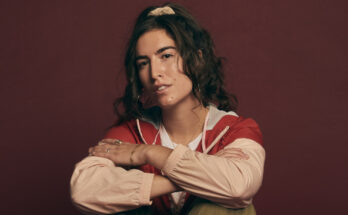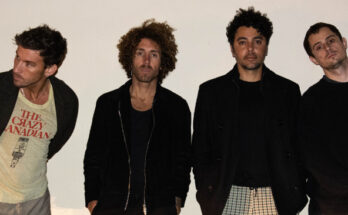The Kennedys, the husband-and-wife duo of Maura and Pete Kennedy, have just released a top-notch new album, “Headwinds.” The much-beloved pair has been known in folk and Americana circles for decades, and rightfully so — their music is a glorious mix of smartly crafted lyrics and songwriting, accompanied by music that will uplift, delight, and entertain. The album is a showcase for the multi-instrumentalists, highlighting their prowess on things like acoustic and electric guitar, vintage steel guitar, piano, organ, and slide ukulele. Headwinds, when they blow, may slow the journey home, but The Kennedys will help you get there with this 13-song collection. We sat down with Maura and Pete recently to talk about this stunning album and their music in depth.
Hi Maura and Pete! You have a terrific new album that just came out on August 25th called “Headwinds.” How did these songs come together and what broad strokes can you tell us about the collection?
Pete: In early 2020, we were already in the planning stages for our next CD, and we knew that we wanted to use various lyrical images to characterize the climate crisis in ways that might spark positive action rather than just making people depressed. Little did we know that the pandemic was about to hit, and,during lockdown, we knew that people globally were feeling the stress of fear, loneliness, and the loss of loved ones. Add in the invasion of Ukraine and our own polarization here in the US, and we had plenty to write about. We still wanted to inspire action or, at the very least, hope in our listeners, so that was the balance beam that we walked in writing the songs.
One of the songs on your new album, “The Boy from the East River Shore,” is really great and stood out to me. What can you tell us about this song? What inspired you to write it and what is it about?
Maura: The song was inspired by a Bob Dylan song called “Red River Shore,” and the subject in his song is a woman. I got the idea to write sort of an answer song where the subject in my song is a man, and the song would be called “The Boy From the East River Shore.” I had that title rolling around in my head for a while before I came up with the story.
We had been living in the East Village of New York City for 20 years, and so that’s where the scene is set. The song is about a young boy from an immigrant family on the Lower East Side who had the unfortunate fate of getting jumped into a street gang at an early age. I hadn’t really ever written a long story song like this before, and I borrowed from the structure of Dylan’s song for this. In fact, the hook line was close enough to Dylan’s that I contacted his publisher in order to share the credits. In my song, the female character tries to help the boy get out of the trap he’s in, and even the cops are keeping a fatherly eye on him, but it’s all too late. That’s the tragedy of gang life — once you get in, it’s extremely difficult to get out.

What was it like recording this album overall? What was the vibe in the studio, and how did this song, in particular, come together?
Pete: Our first two albums, way back in the ’90s, were done partially in recording studios and partially at home. There was a contrast between the two methods. In the studio, we were aware that the clock was ticking and we were on a strict budget. That affects the way you work, and sometimes efficiency might win out over creativity, because you have a time frame in which you have to get each piece of the project done. By the third album, we had switched to doing everything at home, and we never looked back. We approach each song the way a painter, working not on commission but from inspiration, might approach her canvas, taking as much time as we need to let ideas develop organically. That was especially true of Maura’s “The Boy from the East River Shore,” because as a story song, it had to take shape gradually, like a written work of dramatic fiction.
Maura: As a long ballad with no chorus, the evolving story demands attention to the lyrics, but we had to consider how the song stays interesting, musically, over time. I added some high harmonies to the second half of the verses to give them more passion and momentum. Pete had the percussion build throughout the song until the end where it breaks down to what sounds like almost a funeral march to go along with the drama.
Since you started out, how has your songwriting changed — both musically and lyrically? Do different things inspire you now? Where do you tend to get your biggest inspiration from these days?
Maura: For me, I will often notice something that reveals itself to be a metaphor: a hawk in a tree as a warning that nature is in trouble; encountering a headwind while riding a bike as a warning to not get too far away from the important stuff; a dark cloud as a threat of war or climate change. Once I have a metaphor, then I think a lot about how it will work in the song. I love playing with rhyme schemes, too. The more intricate the rhyme scheme, the more satisfying it is to me when I can carry it through the entire song.
In addition, during the pandemic, we learned over 1,000 different songs by other writers, as we presented weekly, hour-long livestreams. When you learn and internalize songs, as opposed to just listening passively, you notice the intricacies and the art that goes into them, and we learned a lot. It was like taking a master class from people like Jimmy Webb, Holland-Dozier-Holland, Gordon Lightfoot, Barry Mann and Cynthia Weil, Burt Bacharach, John Lennon, Paul McCartney, George Harrison, Felice and Boudleaux Bryant, John Fogerty, and literally hundreds of others. I think our own writing has really grown from that experience.
Songwriting can be a really personal endeavor. Is it tough to share that stuff that usually might be private if you weren’t writing a song about it? Does unveiling the songs publicly, when you release a single or an EP or album, make you anxious or is it cathartic to have the songs out there?
Pete: We often create situations and characters out of whole cloth for the purpose of telling a story or constructing a metaphor. Even songs sung in first person might actually be in the voice of one of those characters, and the song’s situation isn’t necessarily our own experience.
Maura: We don’t really write confessional songs. When we do write a song that comes from personal experience, we try to make it translate as universal. A few years ago, I studied tarot cards, and what I found was that when people exclaim that the reading of the hand they were dealt was “dead on” it may be because the tarot cards tend to point out archetypal experiences that we all have to some degree. You could think of that as a parallel of how we try to present our songs — by presenting personal experiences in terms that are universal.
What is one word you’d use to describe how you feel about releasing this album?
Maura: Grateful.
Pete: Attuned.
It’s not uncommon for an artist to be working on something new while promoting an album. Do you have anything in the pipeline to follow this album? What’s next from The Kennedys?
Pete: We both experiment with other types of writing besides creating songs, and, in fact, I’m set to release my second novel later in the year. It’s part two of a trilogy based on the exploits of a fictional character named Artemis Fletcher, a scholar by day but also a global crimefighter who tracks down art and antiquities thieves in all kinds of interesting locations. The book is titled, “Floodwood Chronicles, Part Two: The Wolf of Amalfi,” set to be published in early November.
Web: https://kennedysmusic.com/
YouTube: https://www.youtube.com/thekennedys
Facebook: https://www.facebook.com/The.Kennedys.Fan
Twitter: https://twitter.com/kennedysthe
Instagram: https://www.instagram.com/the_kennedys_music/
Bandsintown: https://www.bandsintown.com/a/47155


